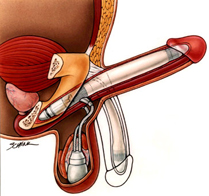Penile Prosthetic Surgery
DESCRIPTION OF PROCEDURE:
This proced ure is carried out to correct sexual dysfunction if it is not treatable by other forms of treatment or if you prefer this treatment over others. This procedure is performed under epidural or general anesthesia. An incision is made at the junction of the penis and the scrotum, the pubic area (two fingers above the base of the penis), or close to the head of the penis, depending on the type of prosthesis being used. Malleable rods and articulating rods are placed in the penis only. Two piece inflatable prostheses have a penile component and pump and reservoir part for placement in the scrotum. Three piece inflatable prostheses have penile/scrotal (pump) components and pelvic/abdominal (reservoir) components. This procedure results in minimal loss of blood and does not require blood transfusion. It takes about 1-3 hours depending on type of prosthesis being inserted and the need for other procedures at the same setting.
ure is carried out to correct sexual dysfunction if it is not treatable by other forms of treatment or if you prefer this treatment over others. This procedure is performed under epidural or general anesthesia. An incision is made at the junction of the penis and the scrotum, the pubic area (two fingers above the base of the penis), or close to the head of the penis, depending on the type of prosthesis being used. Malleable rods and articulating rods are placed in the penis only. Two piece inflatable prostheses have a penile component and pump and reservoir part for placement in the scrotum. Three piece inflatable prostheses have penile/scrotal (pump) components and pelvic/abdominal (reservoir) components. This procedure results in minimal loss of blood and does not require blood transfusion. It takes about 1-3 hours depending on type of prosthesis being inserted and the need for other procedures at the same setting.
POSTOPERATIVE CARE:
You will spend 1-2 hours in recovery. You may/may not be able to eat depending upon your body’s reaction to the anesthetic. You will have a urinary catheter to drain the bladder which will be removed the next day. If you have a drain, it will also be removed the next day. The dressing is removed the next day and you will take sponge baths not showers. You may either stay in the hospital overnight or may go home (but will need to come to clinic the following day) and will be able to go back to work in 1–2 weeks depending on the type of prosthesis. Most patients choose to go home, as they rest and recover more easily. You will be given pain medications and antibiotics to take at home. You should not engage in sexual intercourse until we deem you healed and avoid all strenuous activity that might result in contact with the prosthesis or its components.
ALTERNATIVES:
Pills such as Viagra, urethral insert such as MUSE, injection treatment into the penis, and vacuum suction device with/without injection treatment.
RESULTS:
Initial success rate is over 90%. On average, inflatable prostheses function effectively for 10-15 years and semi-rigid a little longer.
CERTAIN CONSIDERATIONS REGARDING PENILE PROSTHESIS
This is an irreversible procedure and results in extensive distortion of erectile tissue.
Just like any other prosthetic (knee, hip, etc), the erection will NOT be the same as when you were younger and more functional.
It might require surgery in the future for its complications, including its removal. Replacement is not guaranteed.
It does not affect abilities to achieve climax or ejaculation.
Prophylactic antibiotics may be considered for future surgery on other organs such as dental work.
POSSIBLE SIDE EFFECTS AND COMPLICATIONS INCLUDE:
Infection is the most serious complication. It may manifest early (in 10 days or so) or late (in several months or years). The infection rate is higher if you have scar tissue in the penis from Peyronie’s disease or previous implantation.
Device malfunction is about 5% in 5 years, much higher after 5 years. Malfunction includes self-inflation; leakage of fluid, difficult deflation, device failure etc.
Perforation of the prosthesis may occur at the back of the penis behind the scrotum, into the urethra, or at the head of the penis. If perforation of the urethra occurs during surgery, the operation will have to be stopped. If it occurs later, the device will have to be removed or replaced and the site of perforation repaired.
The tubings of a three-piece prosthesis may be injured in future abdominal or scrotal surgery.
Pain may persist for several weeks or even months following surgery.
Tissue loss (necrosis) may occur in patients with vascular disease (diabetes) or patients undergoing extensive reconstruction of the penis for scarring or Peyronie’s disease.
There may be substantial interference with urination with a semi-rigid prosthesis.
Other complications include numbness near the incision which may take several months to resolve, swelling and bruising (blue and black) which may take several weeks to resolve, and some scarring near the incision, etc.
SCHEDULING FOR OPERATION
If you are interested in undergoing this operation, you will likely need a preoperative evaluation by your Primary Care Physician or Cardiologist; they may need you to obtain other tests to make sure you are safe to have an anesthetic. All men will need blood tests and an analysis of the urine, many men will also need an EKG and chest X-ray.
If you have any more questions before or after your operation, please contact Dr. Brant.